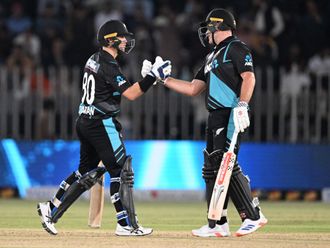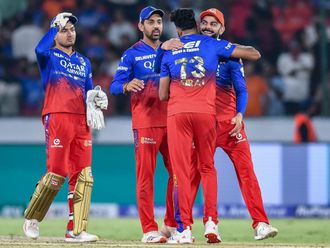
Melbourne: Colour-blind Australia opener Chris Rogers has effectively ruled himself out of playing day-night Tests because he won’t be able to see the pink ball.
Officials announced the planned match between Australia and New Zealand on Tuesday, but Rogers’ teammate Mitchell Starc has hit out at the decision after being part of a trial game.
Starc, named best player at the recent Cricket World Cup, feels not enough thought has gone into how it will impact the game, with the Rogers situation a good example.
“He’s not the only player out there who is going to be affected by seeing the ball,” Starc said.
The paceman says the pink ball it behaved “very differently” to the usual red ball and crowds might not even be able to see it.
Starc also questioned the efficacy of the format as a measure of a cricketer’s career, suggesting night Tests might need to be recorded separately given the vastly different conditions on offer.
“Whether you have to start a whole new set of stats for the pink ball as you do with the red and white ball — it throws up a huge number of questions and theories about where the game is going,” he said.
The 25-year-old left-armer was involved in a round of Sheffield Shield day-night trial matches in Australia but was not convinced by the concept.
“It doesn’t react anything like the red ball, in terms of swing and the hardness of it anyway,” he told media in England, where Australia are preparing for the Ashes.
“It goes soft pretty quickly, I didn’t see a huge amount of reverse swing in that game and I don’t think it swung from memory too much until the artificial light took over.
“It definitely reacts very, very differently to the red ball.
“The other thing as well is, personally, I couldn’t see the thing at night on the boundary. I couldn’t see the ball. So I’m not sure how the crowd are going to see it.
“I understand the pink ball has changed a lot from when it first came in for trials. It’s improved a lot, so Kookaburra has done well there.
“But time will tell if it works with the crowds and the viewership and the way that cricketers respond to it.”
The first day-night Test will be played between Australia and New Zealand on Nov. 27, the third and final match of their series, with administrators hopeful the format can translate to improved crowds and broadcast revenue.
After Tuesday’s announcement, Cricket Australia chief executive James Sutherland insisted the ball was ready for use after years of development and testing.
Starc’s scepticism was at odds with some of his team-mates, including batsman Steven Smith and wicketkeeper Brad Haddin, who both welcomed the initiative.












